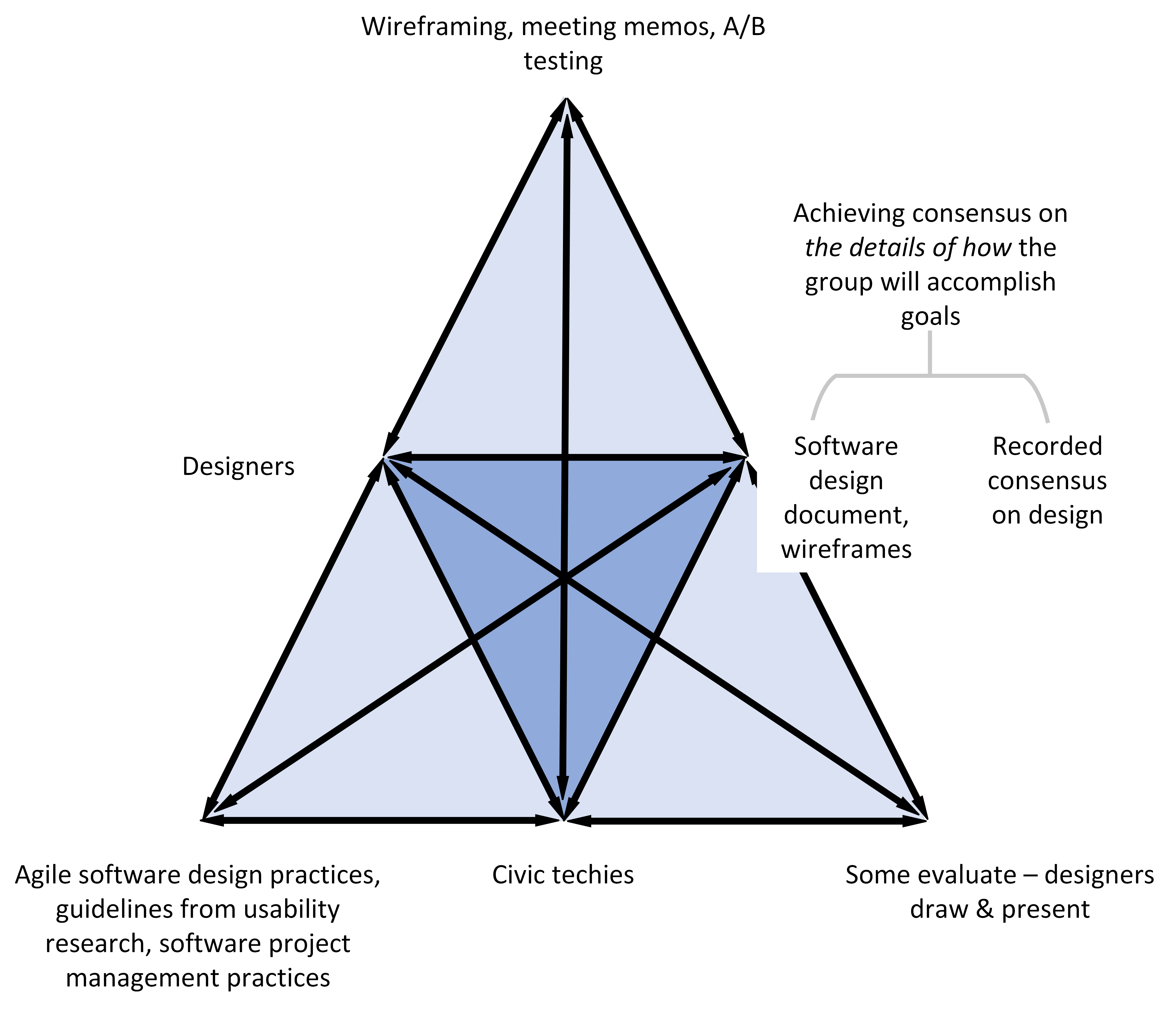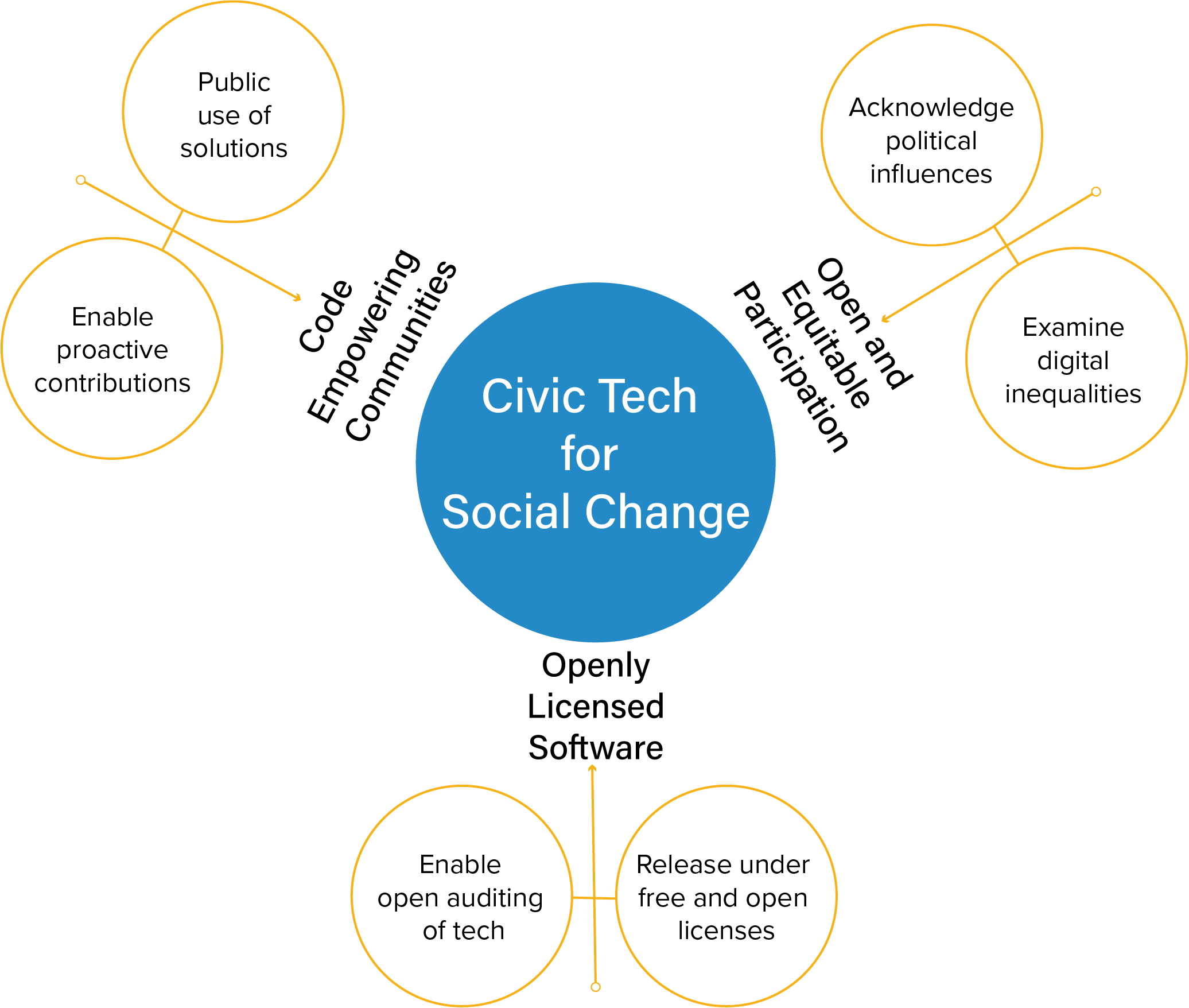25 Feb 2023 ·
1 min read
 Figure: Civic tech software design activity system, as modeled with activity theory
Figure: Civic tech software design activity system, as modeled with activity theory
Volunteers can create change in their community or globally, but steering volunteer technology projects can be a challenge. In this case study, we set out to find out which kind of friction might occur during civic tech projects and in which project stages this might occur.
We applied Engeström’s expanded activity theory as a theoretical lens to analyze motivations, how they relate to for example group goals or development tool supported processes, and what contradictions emerge. Participants agreed on big picture motivations, such as learning new skills or improving the community. The main contradictions occurred inside activity systems on details of implementation, instead of big picture motivations. Two most significant contradictions involved planning, and converging on design and technical approaches. These findings demonstrate the value of examining civic tech development processes as evolving activity systems.
Initial Recommendations
Our recommendations for practice are what perhaps professionals in established volunteering and non-government organisations already know: Have skilled and committed facilitators that can keep volunteers pointed in the same direction and sustain participant engagement. Based on our case study, it appears that it is essential to have: efficient communicators, shared task management tools, and a compromise on technologies that most participants can commit to. Finding an acceptable lowest common technology denominator is important, since participant skill levels in civic tech can vary.
Read More
An open access version of the paper is available in arXiv.
Continue reading
22 Oct 2022 ·
1 min read
 Figure: Three Pillars of Civic Coding Best Practices
Figure: Three Pillars of Civic Coding Best Practices
Read our new magazine article about civic coding and what software engineers should know about it! We’re excited about the opportunity, since the format allows us to condense the highlights from our research into a compact “this is what you need to know” package. It’s a quick read with no paywall, so if you find this topic at the intersection of free/open source software and social change of interest, do follow the link below. We also list below some key highlights from the article.
- Civic coders can accomplish much, but they are also easily sidelined or harmed by activities done by more structured actors.
- When working with civic tech communities, it is important to go beyond the usual requirements engineering process and ensure open and equitable participation.
- Free and open-source software licenses are the key to enabling transparency, agency, and accountability in civic tech projects.
Read More
An open access version of the paper is available in IEEE Xplore.
Continue reading
01 May 2022 ·
2 min read
 Figure: SENSEI initiative participant values (Palacin et al. 2021)
Figure: SENSEI initiative participant values (Palacin et al. 2021)
A while back, I had the opportunity to contribute to a research project where my good colleague Dr. Victoria Palacin led an investigation into what values (as defined by Schwartz values theory) motivate activity and sustained participation in digital citizen science initiatives. It was found that self-transcendence, security, and openness-to-change values influence the participation and use of digital citizen science tools. More specifically, value orientations are linked to usage patterns, where people with a stronger openness-to-change (OTC) value tended to use the mobile application to check others’ submissions and people with stronger security values mostly used the application when they had something relevant to submit.
In the future, deeper understanding of people’s value orientations can contribute to the design of incentive mechanisms, understanding the user experience of online communities, and inform the design of digital citizen science technologies.
Additionally, the co-design process for the initiative, led by Dr. Palacin, was exemplary in my opinion. If you are interested in how to design together with communities or find citations to the design principles, I recommend having a look.
Read More
An open access version of the paper is available in (ScienceDirect open access).
Continue reading
12 May 2021 ·
1 min read
Preamble
I have recently spent most of my time on collaborating with a group of researchers across Europe on the ParCos research project. ParCos aims to change the way that science stories are communicated, by inviting the audience to experience and interpret the data for themselves, and by providing tools and methods.
As a part of stating our position, we are happy to publish our first policy brief, where we detail our perspective on the need for more participatory and open science.
This report, aimed at academics and academic policy makers, will highlight the benefits of not just publishing science data for other scientists but making it easier for the public to use. We will also highlight the benefits of widening the ways in which the public can participate in science research, depending on the level of involvement that they want – whether it is active participation or if it is simply having better access to underlying evidence of published science communications.
Read more
Knutas A., Wolff, A., Hudson, L. (2021). ParCos policy brief, deliverable 7.4 of the Horizon 2020 project ParCos, EC grant agreement no 872500, Lappeenranta, Finland. DOI: 10.5281/zenodo.10847996
Download
Download the PDF from the Zenodo open science repository or the local mirror copy.
Continue reading
18 Feb 2021 ·
3 min read
Recently colleagues and I (Wolff, Pässilä, Knutas, Vainio, Lautala & Kantola) had the opportunity to write a book chapter to the Handbook of Smart Cities. We contributed our thoughts on the importance of creative practices and how the smart city visions have developed in this direction.
Introduction
Urban planning processes have historically been shaped by city visions, such as ‘livable’, ‘sustainable’, or ‘smart’. Such visions evolve according to changing economic circumstances and political ideologies and are driven and supported by new technologies and innovations. Each new urban concept can be seen as a way for a city to differentiate itself against others within an increasingly competitive global economy. Thus, each iteration of the city is propositioned to counter an old, replacing one emphasis with a new. In the chapter, we identify a number of challenges for city design and demonstrate how creative practices may be important as a way of widening participation in design and for building empathy. These approaches might help balance the competing interests of humans, non-humans, and the environment.
Below you can find a clip from our literature review of how the city visions have evolved and then the link to the full book chapter.
Read more
The book chapter is available in SpringerLink and there is a time-locked postprint at LUTPub.
Continue reading
 Figure: Civic tech software design activity system, as modeled with activity theory
Figure: Civic tech software design activity system, as modeled with activity theory Figure: Three Pillars of Civic Coding Best Practices
Figure: Three Pillars of Civic Coding Best Practices Figure: SENSEI initiative participant values (Palacin et al. 2021)
Figure: SENSEI initiative participant values (Palacin et al. 2021)